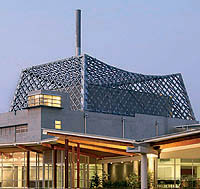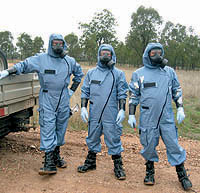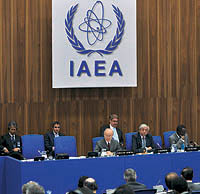Guide to the Report
This report complies with the formal reporting obligations of the Director General ASNO. It also provides an overview of ASNO's role and performance in supporting nuclear safeguards and the non-proliferation of weapons of mass destruction.
The report has five parts:
- a report by the Director General ASNO on key developments in 2010–11 and a preview of the year ahead
- a summary of current major issues
- a functional overview of ASNO, including its operating environment and outcomes-outputs structure–the first outcome demonstrates accountability to Government; the second outlines public outreach and education
- a report on ASNO's performance during 2010–11
- the key features of ASNO's corporate governance and the processes by which ASNO is directed, administered and held accountable.
Because ASNO is funded as a division of the Department of Foreign Affairs and Trade (DFAT), some mandatory annual report information for ASNO is incorporated in the DFAT Annual Report. This includes:
- financial statements
- corporate governance and accountability framework
- external scrutiny
- human resource management, including occupational health and safety
- asset management
- purchasing
- agency specific Social Inclusion strategies
- advertising and market research
- ecologically sustainable development and environmental performance.
A checklist of information included against annual report requirements is set out in the List of Requirements.
User guide (website help and information)
This online Annual Report 2010–2011 is designed to be fast and easy to use. Limited graphics have been used in the page layouts with extensive use of 'style sheets' providing the 'look and feel' of the report. This approach minimises download times for each page giving the user more reading and viewing time with less waiting.
Navigation tools
The tools for navigating around the report have been kept simple. The report is divided into five main sections. Each section has individual navigation tools to enable the user to browse through the section, including descriptive back and previous buttons at the bottom of each page. The table of contents provides a complete sitemap of the report. A list of figures and tables is also available.
Photo gallery
Throughout the report photographs and captions are included. Each of the pictures has a larger version for viewing, select on the actual picture or the "
Enlarge image" link below each picture to view the larger version of the photograph. From each picture page you can return to the associated section of the report using the back button on your browser, or by using a link provided below the caption on each page. A dedicated photo gallery is also available for viewing the photographs.
Accessibility
The coding behind this report is XHTML 1.0 Transitional, a World Wide Web Consortium (W3C) standard that enables users of all web browsers* to access the information contained within the report.
The presentation of this report has been designed to follow the Web Content Accessibility Guidelines, developed by the W3C's Web Accessibility Initiative (WAI) to enable equal access to all users of the Internet.
* The exact display may differ from browser to browser but all information is retained.
PDF versions
Portable Document Format (PDF) versions of the report are available for download.
List of Figures
Figure 1: Quantity and Value of Australian UOC Exports
Figure 2: Civil Nuclear Fuel Cycle
Figure 3: ASNO's Operating Environment
Figure 4: ASNO's Outcomes and Outputs Structure
Figure 5: Nuclear Inspections by ASNO, 2010–11, by type of permit holder
Figure 6: Nuclear Inspections by ASNO, 2010–11, by effort for each type of permit holder
Figure 7: ASNO's Organisational Structure (as at 30 June 2011)
List of Tables
Table 1: UOC Export and Nuclear Electricity Statistics
Table 2: ASNO Reports (line entries) to the IAEA, 2005–11, by facility
Table 3: ASNO Reports (line entries) to the IAEA, 2005–11, by data type
Table 4: Nuclear Material in Australia at 30 June 2011
Table 5: Associated Items in Australia at 30 June 2011
Table 6: Status of Safeguards Permits and Authorities at 30 June 2011
Table 7: IAEA Safeguards Inspections and Complementary Accesses, 2010–11
Table 8: Inventory Differences Recorded during 2010–11
Table 9: Summary of AONM by category, quantity and location at 31 December 2010
Table 10: Supply of Australian Uranium to Customers during 2010–as delivered to customers' converter accounts
Table 11: Summary of AONM Transfers, 2010
Table 12: Permits for CWC-Scheduled Chemical Facilities and Importers
Table 13: ASNO Staff at 30 June 2011
Table 14: Training and Development Activities during 2010-2011
Table 15: ASNO Administrative Costs
Table 16: World Nuclear Energy, June 2011
Table 17: Australia's Bilateral Safeguards Agreements at 30 June 2011
Table 18: States with Additional Protocols in force at 30 June 2011
Table 19: States with an AP Signed or Approved but not in force at 30 June 2011
Table 20: States with Significant Nuclear Activities and no AP at 30 June 2011
Table 21: IAEA Conclusions of Inspections in Australia
Table 22: Status of Australian CTBT IMS Facilities at 30 June 2011
Next section: Director General's Report
Previous section: Table of contents



